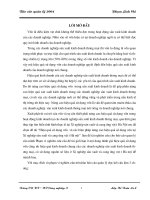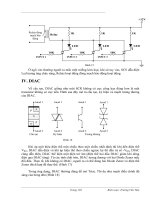Hiểu và quản lý rủi ro lâm sàng understanding and managing clinical risk
Bạn đang xem bản rút gọn của tài liệu. Xem và tải ngay bản đầy đủ của tài liệu tại đây (53.57 KB, 12 trang )
Topic 6
Understanding and
managing clinical risk
Why clinical risk is relevant
to patient safety
o
clinical risk management specifically is
concerned with improving the quality and
safety of health-care services by identifying
the circumstances and opportunities that put
patients at risk of harm and acting to prevent
or control those risks
4-step process to manage
clinical risks
o
o
o
o
identify the risk
assess the frequency and severity of
the risk
reduce or eliminate the risk
cost the risk
Learning objective
Know how to apply risk management
principles by identifying, assessing and
reporting hazards and potential risks in the
workplace
Knowledge requirements
o
o
o
the activities used for gathering information
about risk
fitness to practise requirements
personal accountability for managing clinical
risk
Performance requirements
o
o
o
o
o
o
know how to report known risks or hazards in the
workplace
keep accurate and complete medical records
self-assess to reduce the risk of errors caused by
inadequate knowledge and skills
participate in meetings that discuss risk management
and patient safety
respond appropriately to patients and families after
an adverse event
respond appropriately to complaints
Clinical risk
management activities
o
o
o
o
o
incident monitoring
sentinel events
the role of complaints in improving care
complaints and concerns where the individual
is responsible
coronial Investigations
Sentinel events
o
unexpected occurrence involving death or
serious physical or psychological injury and
includes any process variation for which a
recurrence would carry a significant chance of
serious adverse outcome
JCAHO, 1999
Complaints
o
o
o
o
o
assist in maintaining standards
reduce the frequency of litigation
help maintain trust in the profession
encourage self-assessment
protect the public
Fitness to practise
requirements
credentialling
o accreditation
o registration
o
Professional development
and self-assessment
o
o
o
o
o
role of fatigue and fitness to practise
stress and mental health problems
work environment and organization
supervision
communication
Performance requirements
o
o
o
o
o
o
know how to report known risks or hazards in the
workplace
keep accurate and complete medical records
self-assess to reduce the risk of errors caused by
inadequate knowledge and skills
participate in meetings that discuss risk management
and patient safety
respond appropriately to patients and families after
an adverse event
respond appropriately to complaints









